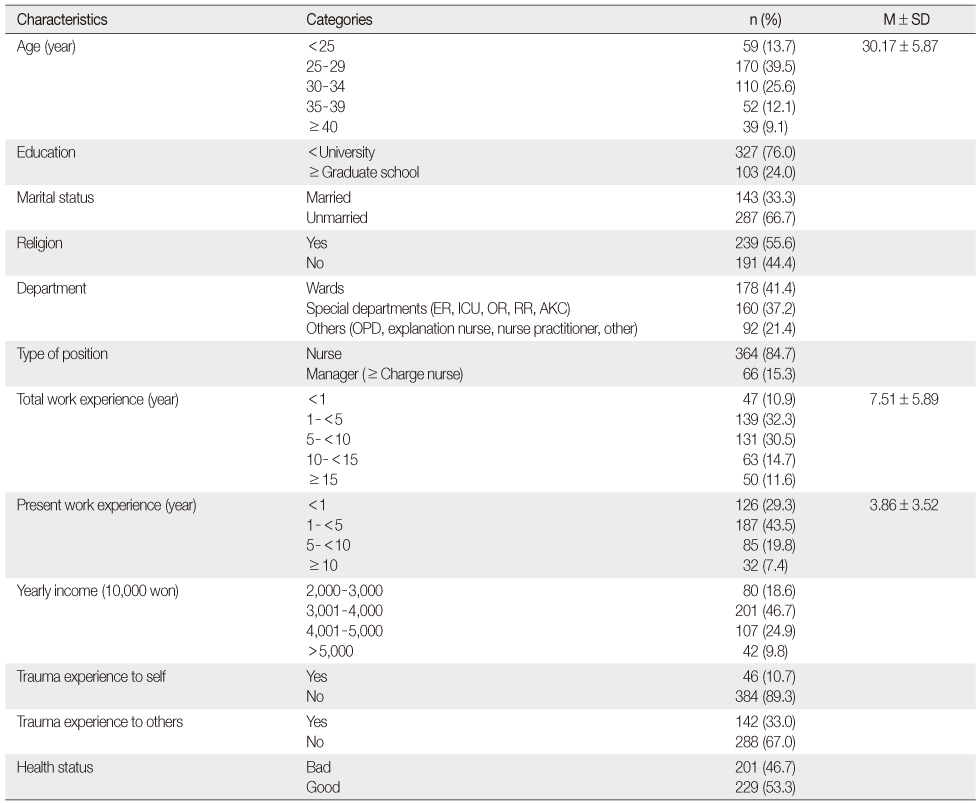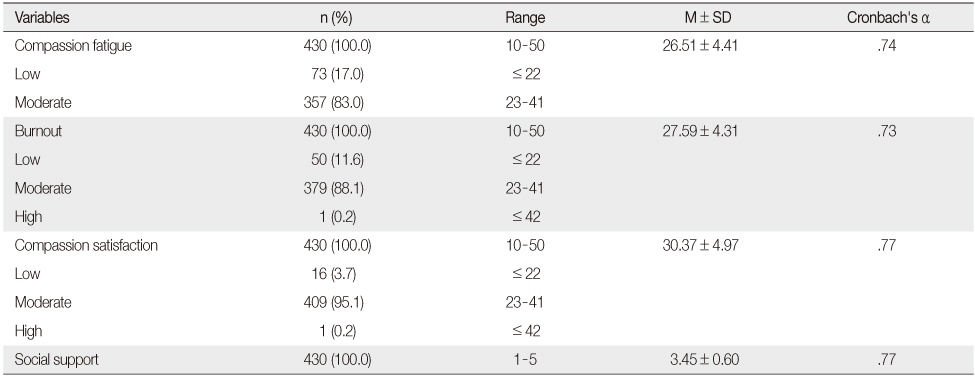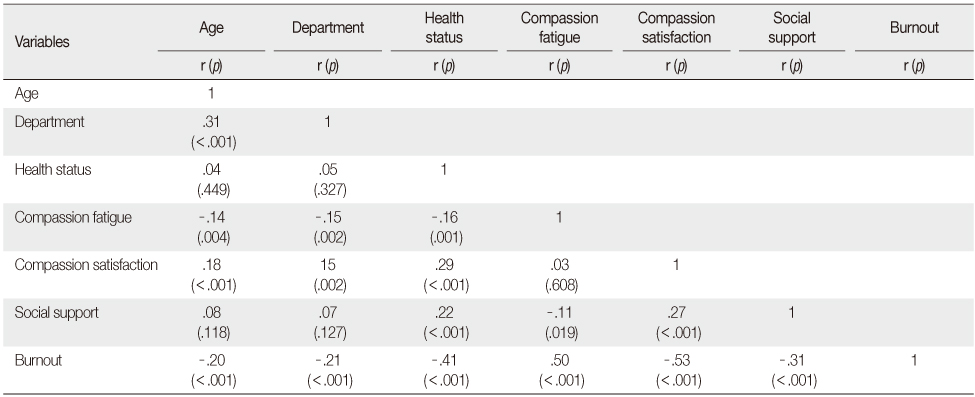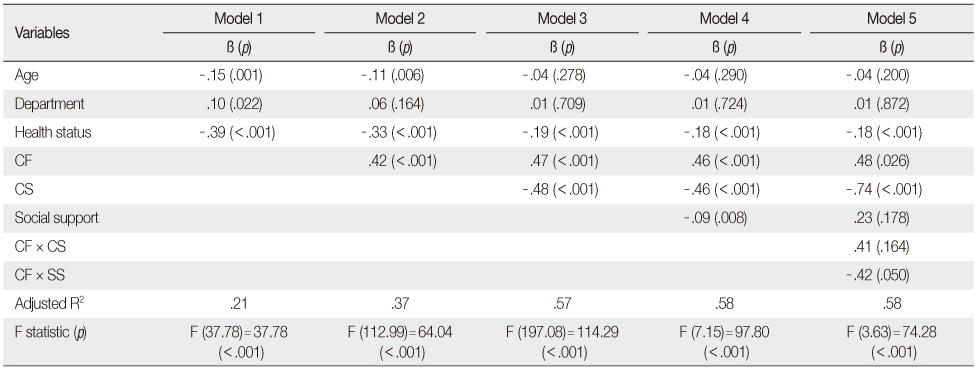Articles
- Page Path
- HOME > J Korean Acad Nurs > Volume 42(6); 2012 > Article
-
Original Article
- Effects of Compassion Satisfaction and Social Support in the Relationship between Compassion Fatigue and Burnout in Hospital Nurses
- Young-Hee Yom, Hyun-Jung Kim
-
Journal of Korean Academy of Nursing 2012;42(6):870-878.
DOI: https://doi.org/10.4040/jkan.2012.42.6.870
Published online: December 31, 2012
1Red Cross College of Nursing, Chung-Ang University, Seoul, Korea.
2Graduate School, Chung-Ang University, Seoul, Korea.
- Address reprint requests to: Kim, Hyun-Jung. Daewon University College, 316 Daehak-ro, Jecheon, Chungbuk 390-702, Korea. Tel: +82-43-649-3207, Fax: +82-43-649-3689, pighj0323@hanmail.net
© 2012 Korean Society of Nursing Science
- 1,159 Views
- 16 Download
- 37 Crossref
Abstract
-
Purpose
- The purpose of this study was to identify the effects of compassion satisfaction and social support in the relationship between compassion fatigue and burnout among hospital nurses.
-
Methods
- The participants were 430 nurses working in general hospitals. Data were collected with self-administrated questionnaires and analyzed by hierarchical multiple regression.
-
Results
- (a) Compassion fatigue had a significant positive effect on burnout; (b) social support and compassion satisfaction had negative effects on burnout, and (c) social support and compassion satisfaction did not moderate the effects of compassion fatigue on burnout.
-
Conclusion
- These findings provide strong empirical evidence for the importance of compassion fatigue, compassion satisfaction and social support in explaining burnout of nurses. Also, it would be of great value to further define compassion fatigue and compassion satisfaction even though these concepts are not accepted in the realities of health care.
- 1. Adams RE, Figley CR, Boscarino JA. The compassion fatigue scale: Its use with social workers following urban disaster. Res Soc Work Pract. 2008;18(3):238–250. http://dx.doi.org/10.1177/1049731507310190.ArticlePubMedPMCPDF
- 2. Alkema K, Linton JM, Davies R. A study of the relationship between self-care, compassion satisfaction, compassion fatigue, and burnout among hospice professionals. J Soc Work End Life Palliat Care. 2008;4(2):101–119. http://dx.doi.org/10.1080/15524250802353934.ArticlePubMed
- 3. Byun DS, Yom YH. Factors affecting the burnout of clinical nurses -focused on emotional labor-. J Korean Acad Nurs Adm. 2009;15(3):444–454.
- 4. Cohen S, Wills TA. Stress, social support, and the buffering hypothesis. Psychol Bull. 1980;98(2):310–357.Article
- 5. Embriaco N, Papazian L, Kentish-Barnes N, Pochard F, Azoulay E. Burnout syndrome among critical care healthcare workers. Curr Opin Crit Care. 2007;13(5):482–488. http://dx.doi.org/10.1097/MCC.0b013e3282efd28a.ArticlePubMed
- 6. Faul F, Erdfelder E, Lang AG, Buchner A. G power 3: A flexible statistical power analysis program for the social, behavioral, and biochemical sciences. Behav Res Methods. 2007;39(2):175–191. http://dx.doi.org/10.3758/BF03193146.PubMed
- 7. Figley CR. Figley CR. Compassion fatigue as secondary traumatic stress disorder: An overview. In: Compassion fatigue: Coping with secondary traumatic stress disorder in those who treat the traumatized. 1995;New York, Brunner-Mazel. 107–119.
- 8. Figley CR. Treating compassion fatigue. 2002;New York, Brunner-Routledge.
- 9. Gentry JE, Baranowsky AB, Dunning K. Figley CR. ARP: The accelerated recovery program (ARP) for compassion fatigue. In: Treating compassion fatigue. 2002;New York, Brunner-Routledge. 123–137.
- 10. Hooper C, Craig J, Janvrin DR, Wetsel MA, Reimels E. Compassion satisfaction, burnout, and compassion fatigue among emergency nurses compared with nurses in other selected inpatient specialties. J Emerg Nurs. 2010;36(5):420–427. http://dx.doi.org/10.1016/j.jen.2009.11.027.ArticlePubMed
- 11. Joinson C. Coping with compassion fatigue. Nursing. 1992;22(4):116118–119. 120. Article
- 12. Kim HJ. The relationships between traumatic events, compassion fatigue, burnout and compassion satisfaction in emergency nurses. 2011;Seoul, Konkuk University. Unpublished master's thesis.
- 13. Kim S, Kim JH, Park JY, Suh EY, Yang HJ, Lee SY, et al. Oncology nurses' professional quality of life in a tertiary hospital. J Korean Clin Nurs Res. 2010;16(3):145–155.
- 14. Ko JW. The effects of personality traits on job satisfaction. Korean J Sociol. 1999;33(2):359–387.
- 15. Ko JW, Seo YJ. Work rewards and occupational commitment of hospital nurses. Korean J Health Policy Adm. 2002;12(13):77–98.Article
- 16. Ko JW, Yom YH. The role of social support in the relationship between job stress and job satisfaction/organizational commitment among hospital nurses. J Korean Acad Nurs. 2003;33(2):265–274.ArticlePDF
- 17. Kong BH. Aesthetical-ethical paradigm of care ethics in nursing. J Korean Acad Nurs. 2002;32(3):364–372.ArticlePDF
- 18. Lombardo B, Eyre C. Compassion fatigue: A nurse's primer. Online J Issues Nurs. 2011;16(1):3. http://dx.doi.org/10.3912/OJIN.Vol16No01Man03.
- 19. Meadors P, Lamson A, Swanson M, White M, Sira N. Secondary traumatization in pediatric healthcare providers: Compassion fatigue, burnout, and secondary traumatic stress. Omega (Westport). 2010;60(2):103–128.ArticlePDF
- 20. Oh JH, Lim NY. Analysis of factors influencing secondary traumatic stress, burnout, and physical symptoms in firefighters. J Korean Acad Fundam Nurs. 2006;13(1):96–106.
- 21. Price JL, Mueller CW. Professional turnover: The case of nurses. 1981;New York, SP Medical and Scientific Books.
- 22. Robins PM, Meltzer L, Zelikovsky N. The experience of secondary traumatic stress upon care providers working within a children's hospital. J Pediatr Nurs. 2009;24(4):270–279. http://dx.doi.org/10.1016/j.pedn.2008.03.007.ArticlePubMed
- 23. Shin MJ. Compassion fatigue, burnout, and compassion satisfaction among child protection agency workers in Korea. 2007;Seoul, Sookmyung Women's University. Unpublished master's thesis.
- 24. Slocum-Gori S, Hemsworth D, Chan WW, Carson A, Kazanjian A. Understanding compassion satisfaction, compassion fatigue and burnout: A survey of the hospice palliative care workforce. Palliat Med. 2011;1–7. Advanced online publication. http://dx.doi.org/10.1177/0269216311431311.
- 25. Son KA, Ko JW. The moderating effect of social support on the relations between teachers' job stress and job satisfaction, and organizational commitment. J Educ Adm. 2007;25(4):73–94.
- 26. Stamm BH. Figley CR. Measuring compassion satisfaction as well as fatigue: Developmental history of the compassion fatigue and satisfaction test. In: Treating compassion fatigue. 2002;New York, Brunner-Routledge. 107–119.
- 27. Stamm BH. The concise proQOL manual. 2009;2nd ed. Pocatello, ID, Professional Quality of Life (ProQOL).org.
- 28. Stamm BH. The concise proQOL manual. 2010;Pocatello, ID, Professional Quality of Life (ProQOL).org.
- 29. Watson J. Nursing: Human science and human care, A theory of nursing. 1988;New York, National League for Nursing.
REFERENCES
Figure & Data
REFERENCES
Citations

- Factors Influencing Burnout in Intensive Care Unit and Emergency Room Nurses for Patients Who Attempted Suicide
Hyo Jung Lee, Nayoon Lee
Journal of Korean Critical Care Nursing.2025; 18(1): 1. CrossRef - Exploring the link between work-related psychosocial factors and professional quality of life among ethiopian healthcare workers: Insights from structural equation modelling analyses
Yitagesu Habtu, Abera Kumie, Medhine Selamu, Mirgissa Kaba, Hidenori Harada, Eshetu Girma, Amal Diab Ghanem Atalla
PLOS ONE.2025; 20(3): e0319870. CrossRef - Understanding the Link Between Nurses' Practice Environment, Emotional Exhaustion, Compassion Satisfaction, and Adverse Events
Neil Bertrand Barnard, Siedine Coetzee
Nursing & Health Sciences.2025;[Epub] CrossRef - Exploring the dynamics of compassion fatigue, compassion satisfaction, and burnout in family caregivers of disabled elderly: A moderated mediation analysis of social support
Qian-qian Yang, Yun-die Chen, Mark Schwade, Qi Zhang
Geriatric Nursing.2025; 65: 103537. CrossRef - Examining predictors of compassion fatigue among Iranian nurses: the role of personality traits and socio-emotional support
Marzieyh Malekiha, Leila Hosseinzadeh, Zeinab Zaremohzzabieh
BMC Nursing.2025;[Epub] CrossRef - Investigating compassion fatigue and predictive factors in paediatric surgery nurses
Eda Ayten Kankaya, Nazife Gamze Özer Özlü, Fatma Vural
Nursing Ethics.2024; 31(5): 845. CrossRef - Experience of violence, social support, nursing practice environment, and burnout on mental health among mental health nurses in South Korea: A structural equation modeling analysis
Jung Suk Park, Hee Kyung Kim, Mihyoung Lee
Applied Nursing Research.2024; 78: 151819. CrossRef - Effects of Job Stress, Social Support, and Infection Control Fatigue on Professional Quality of Life among Nurses in Designated COVID-19 Hospitals
Minyoung Shin, Woojoung Joung
Journal of Korean Academy of Nursing Administration.2023; 29(5): 603. CrossRef - The Influences of Professional Self-Concept, Job Stress, and Coworker Support on Burnout in Oncology Unit Nurses
So Jeong Kim, Kwuy Im Jung
Asian Oncology Nursing.2022; 22(2): 104. CrossRef - Influence of the subfactors of self‐compassion on burnout among hospital nurses: A cross‐sectional study in South Korea
Mi Heui Jang, Yoo Mi Jeong, Geuna Park
Journal of Nursing Management.2022; 30(4): 993. CrossRef - Factors Affecting Turnover Intention of Clinical Nurses in a Tertiary Hospital: Focusing on Fatigue, Nursing Professionalism, and Compassion Satisfaction
Jiyeon Song, Minjeong An
The Korean Journal of Rehabilitation Nursing.2022; 25(1): 40. CrossRef - Burnout, Secondary Traumatic Stress, and Compassion Satisfaction of Military Officers Responding to COVID-19
Seoyoung Baek, Sinwoo Hwang
Journal of Korean Academy of Community Health Nursing.2022; 33(2): 217. CrossRef - Factors Affecting Intensive Care Unit Nurses’ Care Burden of Patients with Hematologic Neoplasm
Jiwon Lee, Da Seul Jeong, Hyunji Jeon, Jin Hee Kim, Dong Yeon Kim
Asian Oncology Nursing.2022; 22(4): 235. CrossRef - Associations among professional quality of life dimensions, burnout, nursing practice environment, and turnover intention in newly graduated nurses
Shu Gong, Jin Li, Xiangdong Tang, Xiaoyi Cao
Worldviews on Evidence-Based Nursing.2022; 19(2): 138. CrossRef - Compassion Satisfaction, Secondary Traumatic Stress, and Burnout among Nurses Working in Trauma Centers: A Cross-Sectional Study
Hyoung Ju Lee, Miyoung Lee, Sun Joo Jang
International Journal of Environmental Research and Public Health.2021; 18(14): 7228. CrossRef - The mediating effects of social support and interpersonal competence on the relationship between empathy and caring efficiency in nursing students
Jisuk Lee, Hyeyoung Cho
The Journal of Korean Academic Society of Nursing Education.2021; 27(2): 186. CrossRef - Prevalence and predictors for compassion fatigue and compassion satisfaction in nursing students during clinical placement
Xiaoyi Cao, Lei Wang, Shenyi Wei, Jin Li, Shu Gong
Nurse Education in Practice.2021; 51: 102999. CrossRef - Factors Affecting Burnout among Tertiary Hospital Nurses during the COVID-19 Outbreak
Geun-Hee Kim, Jun Ok You, Mira Lee, Yunju Choi, Yoon Mi Lee, Ji Hye Shin
Journal of Korean Academy of psychiatric and Mental Health Nursing.2021; 30(4): 390. CrossRef - Korean Clinical Nurses’ Emotional Experiences during the COVID-19 Pandemic
Duck Jin Kim, Moo Yong Cho
Journal of Korean Academy of psychiatric and Mental Health Nursing.2021; 30(4): 379. CrossRef - The Association between Korean Clinical Nurses’ Workplace Bullying, Positive Psychological Capital, and Social Support on Burnout
Seong-Ryeol Bae, Hyon-Joo Hong, Jin-Joo Chang, Sung-Hee Shin
International Journal of Environmental Research and Public Health.2021; 18(21): 11583. CrossRef - A Study on the Job Retention Intention of Nurses Based on Social Support in the COVID-19 Situation
Young-Jae Kim, So-Young Lee, Jeong-Hyung Cho
Sustainability.2020; 12(18): 7276. CrossRef - Compassion satisfaction and fatigue in cardiovascular nurses: A cross-sectional descriptive study
Sima Babaei, Marzieh Haratian
Iranian Journal of Nursing and Midwifery Research.2020; 25(3): 212. CrossRef - A structural equation model analysis of the effects of emotional labor and job stress on depression among nurses with long working hours: Focusing on the mediating effects of resilience and social support
Hye-Sun Jung, Eunmi Baek
Work.2020; 66(3): 561. CrossRef - The Influence of Compassion Fatigue, Compassion Satisfaction, and Hardiness of Burnout in Small and Medium-sized Hospital Nurses
Gyoo-Yeong CHO, Seo-Jeong PARK
JOURNAL OF FISHRIES AND MARINE SCIENCES EDUCATION.2019; 31(2): 510. CrossRef - Effect of Professional Quality of Life on the Professional Self-Concept of Intensive Care Unit Nurses in Tertiary Hospital
Jin Young Hong, Sue Kyung Sohn
Journal of Korean Critical Care Nursing.2019; 12(2): 13. CrossRef - Social support and factors associated with self‐efficacy among acute‐care nurse practitioners
Sophia H Hu, Ya‐Mei Yu, Wen‐Yin Chang, Yen‐Kuang Lin
Journal of Clinical Nursing.2018; 27(3-4): 876. CrossRef - Analysis on the Impacts of Characteristics of role and Social Support of Dental Hygienist on Emotional Labor
Ga-Ryoung Lee
Journal of Digital Contents Society.2018; 19(9): 1707. CrossRef - Teacher Competency for Prevention of Adolescent Risk Behavior and Burnout: The Mediating Effect of Compassion Satisfaction and Compassion Fatigue
Sun Young Jung, Hyun Sook Park, Hyun Ju Yeo
Korean Journal of Child Studies.2017; 38(4): 91. CrossRef - The Effects of Communication Skills, Compassion Satisfaction, Compassion Fatigue on Burnout among Staff of Long-term Care Insurance for the Elderly in National Health Insurance Services in Korea
Hyoungshim Choi, Kyongeun Lee, Eunhee Cho
Korean Journal of Occupational Health Nursing.2016; 25(1): 19. CrossRef - Effects of Psychiatric Nurses' Secondary Traumatic Stress and Compassion Satisfaction on Burnout: The Moderating Effect of Social Support
Hyun Jung Lee, Ji Young Kim
Journal of Korean Academy of Psychiatric and Mental Health Nursing.2016; 25(4): 399. CrossRef - Analysis of Research on Compassion Satisfaction among Nurses
Soon-Neum Lee, Jung-A Kim
Journal of the Korea Academia-Industrial cooperation Society.2016; 17(9): 599. CrossRef - Effects of Nursing Practice Environment, Compassion Fatigue and Compassion Satisfaction on Burnout in Clinical Nurses
Mi Young Han, Min Sook Lee, Ju Young Bae, Young Suk Kim
Journal of Korean Academy of Nursing Administration.2015; 21(2): 193. CrossRef - A Meta analysis of variables related to Burnout of nurse in korea
Sin-Hayng Kim, Yoon-Seo Yang
Journal of Digital Convergence.2015; 13(8): 387. CrossRef - Relation of Compassionate Competence to Burnout, Job Stress, Turnover Intention, Job Satisfaction and Organizational Commitment for Oncology Nurses in Korea
Sun-A Park, Seung-Hee Ahn
Asian Pacific Journal of Cancer Prevention.2015; 16(13): 5463. CrossRef - The Impact of Social Support and Self-esteem on Nurses' Empowerment
Myung-Ja Kim, Hyun-Young Kim
Journal of Korean Academy of Nursing Administration.2014; 20(5): 558. CrossRef - Structural Equation Modeling on Burnout in Clinical Nurses based on CS-CF Model
Hyun-Jung Kim, Young-Hee Yom
Journal of Korean Academy of Nursing.2014; 44(3): 259. CrossRef - Study of the Relationship between Compassion Fatigue, Somatization and Silencing Response among Hospital Nurses: Focusing on the Mediating Effects of Silencing Response
Sun Hwa Kim, Tae Wha Lee
Korean Journal of Adult Nursing.2014; 26(3): 362. CrossRef
General Characteristics of the Participants (N=430)
ER=Emergency room; ICU=Intensive care unit; OR=Operating room; RR=Recovery room; AKC=Artificial kidney center; OPD=Outpatient department.
Descriptive Statistics of Variables (N=430)
Correlation among Variables (N=430)
Moderating Effect of Compassion Satisfaction and Social Support between Compassion Fatigue and Burnout
CF=Compassion fatigue; CS=Compassion satisfaction; SS=Social support.
ER=Emergency room; ICU=Intensive care unit; OR=Operating room; RR=Recovery room; AKC=Artificial kidney center; OPD=Outpatient department.
CF=Compassion fatigue; CS=Compassion satisfaction; SS=Social support.
 KSNS
KSNS
 E-SUBMISSION
E-SUBMISSION




 Cite
Cite

